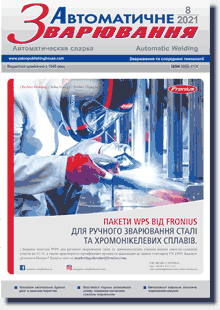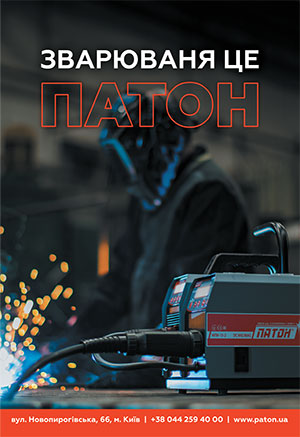| 2021 №08 (09) |
DOI of Article 10.37434/as2021.08.01 |
2021 №08 (02) |

"Avtomatychne Zvaryuvannya" (Automatic Welding), #8, 2021, pp. 3-8
Fatigue life of specimens from 40KH steel after wear-resistant
V.V. Knysh, S.O. Solovej, I.O. Ryabtsev, A.A. Babinets
E.O. Paton Electric Welding Institute. 11 Kazymyr Malevych Str., 03150 Kyiv, Ukraine. E-mail: office@paton.kiev.ua
Studied was the fatigue fracture resistance of a multilayer maetrial, in which the wear-resistant layer was deposited with PP-Np-25Kh5FMS flux-cored wire with a sublayer from a low-alloy material, deposited with PP-Np-12Kh1MF wire. The surfaced specimens design and their testing procedure simulated the operating conditions of steel mill rolls. The integrated procedure of evaluation of fatigue fracture resistance of multilayer surfaced specimens included three stages: determination of cyclic fatigue life of the specimens after fabrication surfacing; studying the cyclic crack resistance of different deposited layers; determination of fatigue life of specimens, having fatigue cracks in the deposited layer during previous testing, after their repair surfacing. It is found that the cyclic fatigue life of specimens from 40Kh carbon steel, surfaced with PP-Np-25Kh5FMS flux-cored wire with a sublayer of 12Kh1MF low-alloy steel is in the range of 346…716 thous. cycles at maximum stress level of 500 MPa. Features of fatigue fracture kinetics of the studied multilayer material were determined. It was established that the fatigue crack propagates in an unstable manner in the deposited metal (in the wear-resistant layer and low-alloy steel sublayer), constantly changing its rate and direction. It is shown that cutting out fatigue cracks and subsequent surfacing of their removal areas allows restoring the cyclic fatigue life of the specimen to the initial level, i.e. doubling the total life. 16R ef., 4 Tabl., 7 Fig.
Keywords: arc surfacing, repair surfacing, sublayer, fatigue life, fatigue crack, stress intensity factor.
Received: 09.06.2021
References
1. Du Toit, M., Van Niekerk, J. (2010) Improving the Life of Continuous Casting Rolls Through Submerged Arc Cladding with Nitrogen-Alloyed Martensitic Stainless Steel. Welding in the World, 54(11-12), 342-349. https://doi.org/10.1007/BF032667482. Jhavar, S., Paul, C.P., Jain, N.K. (2013) Causes of failure and repairing options for dies and molds: A review. Engineering Failure Analysis, 34, 519-535. https://doi.org/10.1016/j.engfailanal.2013.09.006
3. Ahn, D.-G. (2013) Hardfacing technologies for improvement of wear characteristics of hot working tools: A Review. International Journal of Precision Engineering and Manufacturing, 14(7), 1271-1283. https://doi.org/10.1007/s12541-013-0174-z
4. Zhang, J., Zhou, J., Tao, Y. et al. (2015) The microstructure and properties change of dies manufactured by bimetal-gradient- layer surfacing technology. The International Journal of Advanced Manufacturing Technology, 80, 1807-1814 (2015). https://doi.org/10.1007/s00170-015-7170-7
5. Gao, F., Zhou, J., Zhou, J. et al. (2017) Microstructure and properties of surfacing layers of dies manufactured by bimetal- gradient-layer surfacing technology before and after service. The International Journal of Advanced Manufacturing Technology, 88, 1289-1297. https://doi.org/10.1007/s00170-016-8679-0
6. Vundru, C., Paul, S., Singh, R., Yan, W. (2018) Numerical analysis of multi-layered laser cladding for die repair applications to determine residual stresses and hardness. Procedia Manufacturing, 26, 952-961. https://doi.org/10.1016/j.promfg.2018.07.122
7. Ryabtsev, I.A., Senchenkov, I.K. (2013) Theory and practice of surfacing works. Kiev, Ekotekhnologiya [in Russian].
8. Rjabcev, I.A., Senchenkov, I.K., Turyk, Je.V. (2015) Naplavka. Materialy, tehnologii, matematicheskoe modelirovanie [Surfacing. Materials, technologies, mathematical modeling]. Gliwice, Wydawnictwo politechniki slaskiej [in Russian].
9. Babinets, A.A., Ryabtsev, І.A. (2016) Fatigue life of multilayer hard-faced specimens. Welding International, 30, 4, 305-309. https://doi.org/10.1080/01431161.2015.1058004
10. Ryabtsev, I.O., Knysh, V.V., Babinets, A.A. et al. (2020) Fatigue life of specimens after wear-resistant, manufacturing and repair surfacing. The Paton Welding J., 9, 19-25. https://doi.org/10.37434/tpwj2020.09.03
11. Ryabtsev, І.О., Knysh, V.V., Babinets, A.A., Solovej, S.O. (2021) Fatigue life of steel 40Kh specimens after wear-resistant surfacing with a sublayer of low-carbon steel. Ibid, 3, 2-8. https://doi.org/10.37434/tpwj2021.03.01
12. Oberg, E. et al. (1996) Machinery`s Handbook (25th ed.), Industrial Press Inc.
13. Murakami, Yu. (1990) Reference book on stress intensity efficients. In: 2 Vol. Moscow, Mir [in Russian].
14. (2004) Mechanical stress control device and deformations in solid media. Pat. UА 71637 С2.
15. Kaierle, S., Overmeyer, L., Alfred, I. et al. (2017) Single-crystal turbine blade tip repair by laser cladding and remelting. CIRP Journal of Manufacturing Science and Technology, 19, 196-199. https://doi.org/10.1016/j.cirpj.2017.04.001
16. Kim, D.-Y., Kim, D., Kang, M., Kim, Y.-M. (2017) Improvement of fatigue strength of lap fillet joints by using tandem MAG welding in a 590-MPa-grade galvannealed steel sheet. The International Journal of Advanced Manufacturing Technology, 93(9-12), 4379-4387. https://doi.org/10.1007/s00170-017-0828-6
Advertising in this issue:
The cost of subscription/purchase order journals or individual articles
| Journal/Currency | Annual Set | 1 issue printed |
1 issue |
one article |
| TPWJ/USD | 384 $ | 32 $ | 26 $ | 13 $ |
| TPWJ/EUR | 348 € | 29 € | 24 € | 12 € |
| TPWJ/UAH | 7200 UAH | 600 UAH | 600 UAH | 280 UAH |
| AS/UAH | 1800 UAH | 300 UAH | 300 UAH | 150 UAH |
| AS/USD | 192 $ | 32 $ | 26 $ | 13 $ |
| AS/EUR | 180 € | 30 € | 25 € | 12 € |
| SEM/UAH | 1200 UAH | 300 UAH | 300 UAH | 150 UAH |
| SEM/USD | 128 $ | 32 $ | 26 $ | 13 $ |
| SEM/EUR | 120 € | 30 € | 25 € | 12 € |
| TDNK/UAH | 1200 UAH | 300 UAH | 300 UAH | 150 UAH |
| TDNK/USD | 128 $ | 32 $ | 26 $ | 13 $ |
| TDNK/EUR | 120 € | 30 € | 25 € | 15 € |
AS = «Automatic Welding» - 6 issues per year;
TPWJ = «PATON WELDING JOURNAL» - 12 issues per year;
SEM = «Electrometallurgy Today» - 4 issues per year;
TDNK = «Technical Diagnostics and Non-Destructive Testing» - 4 issues per year.









